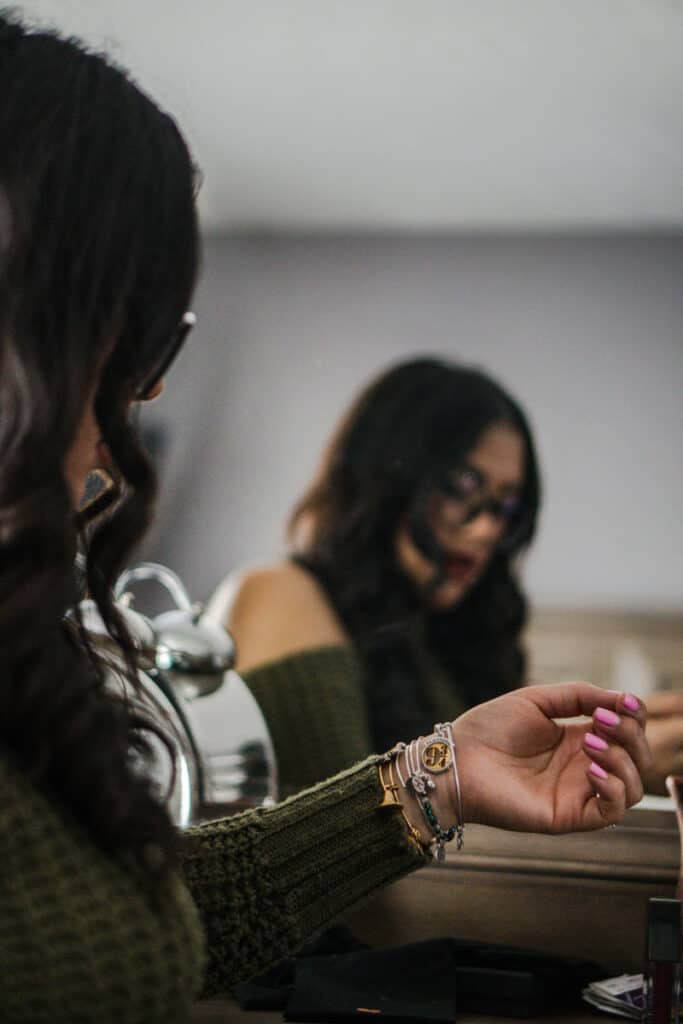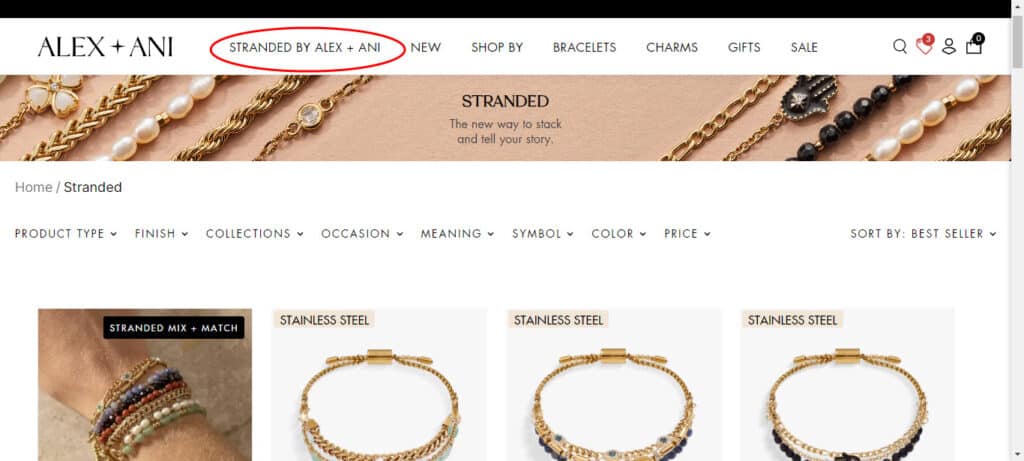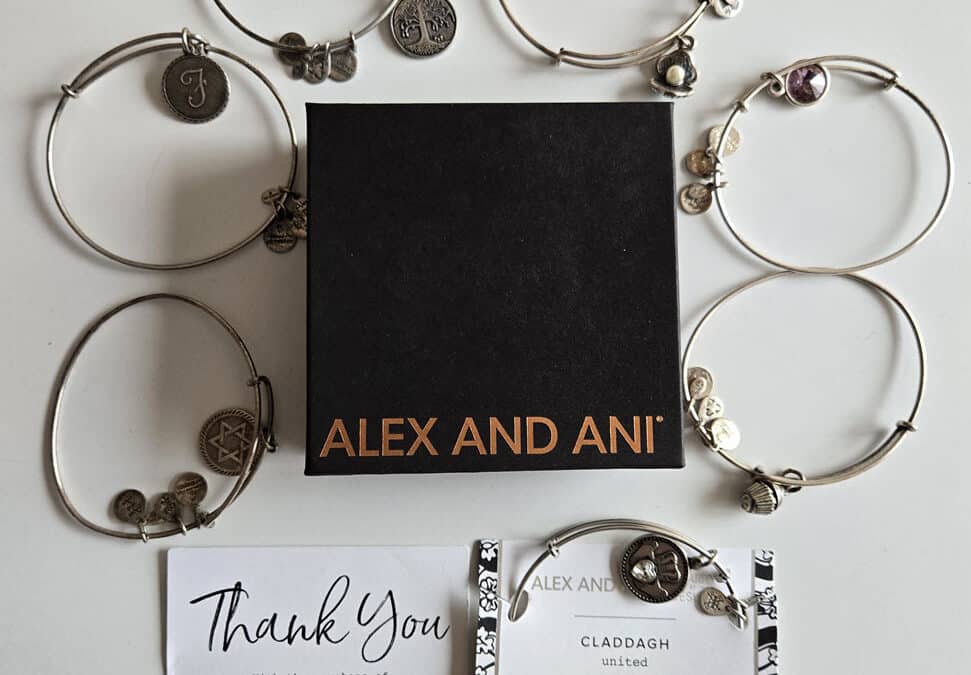Two days before my daughter Fiona’s bat mitzvah in June 2013, my mother-in-law’s cousin Beth dropped off a beautifully-wrapped, 3 ½-inch square box.
Inside were two Alex and Ani bracelets. One charm had a script initial F, the other had a Jewish star.
I had never heard of Alex and Ani. But Fiona’s face lit up. Her excitement told me our 70-something cousin had nailed the gift.
Like anything you suddenly become aware of, I started to see Alex and Ani bracelets everywhere.
Friends of Fiona and other teenage girls had clusters of them piled on their wrists.
Alex and Ani opened a store near us in Wellesley, Massachusetts, an upscale Boston suburb. Fiona and I accompanied my son AJ when he went there to get a sweet 16 gift for a friend.
The store was an experience. Enthusiastic salespeople, all late-teen or 20-something women, greeted us warmly, asked our purpose, and offered help.
They wanted to know if the gift recipient believed in the transformative power of jewelry.
Display cases ran the perimeter of the small, rectangular shop, and contained bracelets with charms for every possible identity marker a woman could imagine: daughter, mom, grandmother, best friend, every initial in the alphabet, Red Sox fan, Yankee fan, insert-your-sports-team-here fan.
Other charms were emblems, like the tree of life and the Claddagh, which symbolizes love, loyalty, and friendship. Bracelets cost $30-$40 each.
The store’s aura, enthusiastic salespeople, meaningful charms, and affordable prices explained why these simple bangles were so popular among teenage girls.
Wellesley seemed to be a good market for them. I was surprised when the shop closed less than three years later.
Alex and Ani’s Insightful Start
Carolyn Rafaelian was granted a patent on “an expandable wire bangle bracelet” on March 23, 2004. The simple design put the focus on the charm that adorned it.
Having recently taken over Cinerama, Inc., her father’s costume jewelry factory in Cranston, Rhode Island, Rafaelian started a company to market her bracelets. She named it after her two eldest daughters, Alex and Ani.
Rafaelian understood that women chose jewelry to reflect their persona, to express who they are and who they aspire to be.
For this reason, she sought to infuse her charms with “positive energy” and studied symbols and runes.
The messages of well-being, empowerment, and uplift made Rafaelian’s creations irresistible to customers and flavored the brand’s early culture.

Photo by Marcus Bellamy on Unsplash
Rafaelian also proved a savvy and creative marketer.
In 2004, she sent Gwyneth Paltrow a bangle with an apple charm to congratulate her on the birth of her daughter, Apple. Images of Paltrow wearing the bangle gave Alex and Ani an immediate boost.
Alex and Ani’s Auspicious Ascent
Alex and Ani gained other celebrity fans like Anne Hathaway, Miley Cyrus, and Sandra Bullock.
Sales grew from $654,000 in 2006 to $2.2 million in 2009, the year Alex and Ani opened their first store, in Newport, Rhode Island.
As a leader, Rafaelian leaned into spirituality, using astrology, Biblical Numerology and New Age practices like tarot card readings to make business decisions.
After meeting Giovanni Feroce at a University of Rhode Island alumni homecoming event in October 2009, Rafaelian hired him as CEO in April 2010. She took the role of Chief Creative Officer.
Feroce was a former elite Army officer. He insisted on complete operational control.
Feroce struck deals with Saks Fifth Avenue and other department stores. He inked licensing agreements with Walt Disney, the National Football League, and the Marines.
Alex and Ani enjoyed distribution through hundreds of mom-and-pop jewelry stores, and opened nearly 40 branded stores like the one in Wellesley.
Sales soared from $4.5 million in 2010 to $230 million in 2013. The employee count reached 1,084 by the end of 2013.
In 2012, JH Partners, a San Francisco private-equity firm, purchased a 40 percent holding in Alex and Ani for $50 million.
A Billion at 10
On March 13, 2014, Feroce suddenly left the company.
Feroce told The Providence Journal his departure came over a difference with Rafaelian over how fast the brand should grow.
Feroce envisioned making Alex and Ani a lifestyle brand – think apparel, home goods, perfume, accessories, like Ralph Lauren or Michael Kors. He wanted to hire a team of designers to speed development.
A former executive said Rafaelian pushed him out, along with anyone loyal to him.
The exodus drained management and included the chief financial officer, chief technical officer, chief strategy officer, chief digital officer, acting chief operating officer, assistant general counsel and VPs of retail, wholesale, and transitional operations.
Though Rafaelian declined to comment, she had told The Providence Journal in July 2012 “The company’s an extension of me.”
My guess is Feroce’s desire to bring in a design team for other lifestyle product lines threatened Rafaelian’s view of the brand as an extension of herself. She could not give up control.
Rafaelian retook the reins as CEO, and never let go.
She continued her New Age and spiritual practices, burning sage to purge areas of bad energy and having shamans bless product inventory.
Sales reached $350 million in 2014.
In December 2014, JH Partners sold their 40-percent stake to British buyout firm Lion Capital LLP for $400 million.
That transaction effectively valued Alex and Ani at $1 billion.
Alex and Ani’s Rocky Adolescence
With Lion Capital’s investment, talk of an initial public offering began. Professional management sought to reduce costs.
I’m betting the Wellesley store’s high rent was a casualty of the cost cutting and the reason it closed in early 2016.
Alex and Ani took a $170 million loan from Bank of America (BOA) in 2016 to buy Cinerama, Inc. from Rafaelian and her sister. Acquiring the factory was seen as vertical integration move.
Rafaelian hired presidents, but undermined them. Harlan Kent, former CEO of Yankee Candle, lasted less than a year.
His successor, Cindy DiPietrantonio, left after two years in December 2017.
From the outside, Alex and Ani seemed to chime along, finishing 2017 with $550 million in sales. Rafaelian graced the cover of Forbes magazine as the poster girl for women billionaires.
Inside, however, turmoil reigned.
The brand lost much institutional knowledge with the top management exodus and struggled to maintain retail relationships. Alex and Ani closed stores, endured rounds of layoffs, and cut digital marketing and event budgets.
Employees who had loved working there now feared for their jobs.
Rafaelian hired a new CFO and tried to run the brand herself. She told a Forbes reporter, “I don’t listen, which is the best thing I do.”
The brand’s belt-tightening included a new direct-to-consumer strategy in 2018, aiming to have 75-80% of sales go through the company website or company stores within 18 months.
Mom-and-pop jewelry stores that helped build the brand were cut off. Retailers felt abandoned.
Sales dipped to $500 million for 2018. Interest in the bangles was waning. Earnings (EBITDA) plummeted to less than $10 million.
When BOA saw the earnings, they held the company in default of their loan and moved to liquidate it.
Lion Capital struck an agreement with BOA to prevent liquidation, which stipulated Rafaelian had to give up her controlling interest in the company.
Barely Alive at 20
Lion Capital brought in a new CEO, Bob Trabucco, but the ship was sinking fast. Sales were down 40% in the fourth quarter of 2019 compared to 2018 and continued to tank.
Pandemic-induced store closings exacerbated the situation. Alex and Ani terminated Rafaelian’s employment in 2020 and filed for bankruptcy in 2021.
While some companies manage to rebuild during bankruptcy, Alex and Ani is swirling down the drain.
At the beginning of 2023, the company had 38 stores in the US. In June 2023, they closed 21 stores and their corporate headquarters overnight, leaving them with only 7 stores and no presence in their home state of Rhode Island.
Employees and store managers were shocked.
Equipment and furnishings left behind were auctioned off in November 2023.
Multiple creditors claimed unpaid bills.
Among them, Alex and Ani owed the town of East Greenwich, RI over $251,000 in back taxes, their corporate-office landlord nearly $458,000 in rent, and a local videographer $1,500 for video production.
It’s ironic and sad that Alex and Ani’s website recently launched a line of pearl products called “Stranded by Alex and Ani.” That’s how their employees and creditors felt.

Why Alex and Ani Imploded
How did a brand worth a billion sink to beans?
First, Alex and Ani’s founder could not step back when her leadership was no longer relevant.
In my book Teenage Wastebrand: How Your Brand Can Stop Struggling and Start Scaling, the diciest brand adolescent symptom I discovered was asserting independence.
Brands assert independence when they outgrow their founder’s skillset. The symptom is dicey because founders often fail to realize the situation or choose to ignore it.
Rafaelian ignored it.
Rafaelian’s insights on jewelry and spiritual leadership gave Alex and Ani a great start, but the brand needed professional leadership to grow. Rafaelian saw that and hired Feroce. He and his team grew the brand exponentially.
But she pushed him and the presidents who succeeded him out.
When Rafaelian tried to preside, the brand declined. Waning consumer interest and pandemic store closures turned the decline into a freefall.
Second, the founder’s hubris and conflicts of interest drained the company.
Rafaelian’s swift retribution against Feroce’s management team deprived the brand of relationships and institutional know-how. The company went from well-oiled machine to scrambling.
Rafaelian prioritized her control over the brand’s health.
True to her word, she didn’t listen to the presidents she hired and undermined them, depriving the company of professional leadership.
The loan to purchase the factory she owned burdened the company financially and put it at risk. Yet she entered the loan, which she stood to benefit from.
When BOA ruled the loan in default, it nearly killed the company. Rafaelian risked the company’s viability to fill her personal coffers.
Third, management chaos and investor-prompted cost-cutting alienated Alex and Ani’s constituents and commoditized the brand.
Waves of layoffs strained the company’s ability to operate, stranded thousands of employees, and demoralized those who remained.
Alex and Ani’s partners struggled to communicate with the company as their contacts were suddenly gone. When the brand became unreliable, they cut ties.
Mom-and-pop stores that provided the kind of personal selling that promoted Alex and Ani’s aura were cut off in favor of direct selling. As company stores closed, the brand lost many of its strongest advocates.
Alex and Ani’s website could not present the brand the way an informed salesperson could. The brand lost its meaning and differentiation.
Fourth, the brand failed to diversify.
The Alex and Ani brand stood for empowerment, wellness, and uplift. Feroce was right to look to expand beyond jewelry. When interest in the bangles waned, customers had nothing else to keep them engaged with the brand.
Alex and Ani succumbed to brand adolescence and is unlikely to recover.
If you are the founder, your brand’s survival depends on your ability to lead or find someone who can.
- Be honest about the skills, energy, and mindset you bring.
- Assess periodically what your brand needs to grow.
- Be willing to bring in a new leader if you are burned out, no longer having fun, or lacking the tools your brand needs.
Reid Hoffman (LinkedIn) and Clay Collins (LeadPages) shared their thinking when they decided to step down as CEO. You can see their thoughts and find questions to help you assess your CEO fitness here.
Moving on from Alex and Ani
JH Partners were the big money winners. They turned $50 million to $400 million in two years and got out while things were good.
Carolyn Rafaelian had her net worth plummet from $1 Billion to $100 million and had to sell some of her properties. She started two other jewelry companies.
As for Fiona, she has not worn her Alex and Ani bracelets in years. She said they became annoying because they clanked loudly and banged against the desk when she wrote.
It speaks volumes that she left her collection at home, thousands of miles from where she is in grad school.
Did you know anyone with an Alex and Ani bracelet or own one yourself?
***
Just for Fun
Saalt’s humor introduces teen girls, women and yes, even dad, to their period cup. (4 minutes, 34 seconds)
SNL mocks the charm-as-identity-marker gift giving. (1 minute, 34 seconds)
What Vincent Van Gogh and Frida Kahlo might endure if they had to cater to corporate interests (2 minutes, 44 seconds, h/t Rohit Bhargava)
If you liked this post, you’ll love the next one. Get future posts right to your inbox by subscribing here.


This is a great story packed with insights. Between hubris, not being willing to expand the product concept, alienating retailers, and demoralizing their employees…they’ve done it all.
So well told and a valuable lesson in what not to do!
Thanks Jill! Glad you found it insightful. My heart goes out to the dedicated Alex and Ani employees who gave their energy and effort to build the brand and felt sad and stranded at its fast demise.